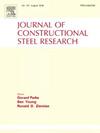Impact performance of hollow steel tubes under low temperatures
IF 4
2区 工程技术
Q1 CONSTRUCTION & BUILDING TECHNOLOGY
引用次数: 0
Abstract
This study presents the test and numerical investigations on the behaviours of hollow circular steel (HCS) tubes under coupled actions of transverse impact and low temperatures. Thirteen HCS tubes were prepared and tested to evaluate the influences of the low temperature, impact energy and steel tube thickness on the impact-resistance performance. The failure pattern, mid-span deformation and impact force were obtained and analyzed. Test results showed that HCS tubes experienced significant local deformation and global deflection under lateral impact. As the temperature dropped from 20 °C to −70 °C, the plateau impact force increased by 13.4 %–20.8 %, while the maximum deflection decreased by 15.1 %–27.1 %. In addition, finite element (FE) models were developed and validated against the test data. With the validated numerical model, dynamic response and working mechanism of HCS tubes were further investigated through analyses of the full-range motion and stress distribution. Local indentation primarily developed during the initial impact phase, while global deflection reached its peak at the end of the plateau phase. During the declining phase, the stress in the steel tube decreased as the elastic deformation recovered. Based on the experimental and numerical results, an empirical formula was proposed for predicting the local deformation of HCS tubes subjected to the combined effects of impact and low temperatures. This formula incorporated the influences of temperature, tube thickness, tube length, tube diameter, impact velocity, and impact mass. Generally, the empirical formula provides accurate prediction.
求助全文
约1分钟内获得全文
求助全文
来源期刊

Journal of Constructional Steel Research
工程技术-工程:土木
CiteScore
7.90
自引率
19.50%
发文量
550
审稿时长
46 days
期刊介绍:
The Journal of Constructional Steel Research provides an international forum for the presentation and discussion of the latest developments in structural steel research and their applications. It is aimed not only at researchers but also at those likely to be most affected by research results, i.e. designers and fabricators. Original papers of a high standard dealing with all aspects of steel research including theoretical and experimental research on elements, assemblages, connection and material properties are considered for publication.
 求助内容:
求助内容: 应助结果提醒方式:
应助结果提醒方式:


